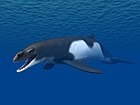Idiocetus
Appearance
| Idiocetus Temporal range:
| |
|---|---|

| |
| Atlas of I. guicciardinii, from Italy | |
| Scientific classification | |
| Domain: | Eukaryota |
| Kingdom: | Animalia |
| Phylum: | Chordata |
| Class: | Mammalia |
| Order: | Artiodactyla |
| Infraorder: | Cetacea |
| Family: | Balaenidae |
| Genus: | †Idiocetus Capellini 1876[1] |
| Species | |
| |
Idiocetus ("unique whale") is a genus of extinct cetaceans of the family Balaenidae.[2]
Discovery
Fossils belonging to this genus were first found in Piacenzian (Upper Pliocene) strata near Montopoli in Val d'Arno, a town in Tuscany (central Italy). The Italian paleontologist Giovanni Capellini described the whale in 1876 and attributed it to a new genus and species, establishing the type species Idiocetus guicciardinii. Some decades later, in 1926, other fossil remains possibly belonging to the genus were discovered from the Tortonian (Upper Miocene) of Japan.[3]
References
- ^ Capellini, G., 1876. "Sulle balene fossili toscane". Atti della Reale Accademia dei Lincei 3: 9–14.
- ^ Steeman, M. E. (2010). "The extinct baleen whale fauna from the Miocene–Pliocene of Belgium and the diagnostic cetacean ear bones". Journal of Systematic Palaeontology. 8 (1): 63–80. doi:10.1080/14772011003594961. OCLC 694418047.
- ^ Idiocetus on Fossilworks.org
Further reading
Capellini, G., 1905. "Balene fossili toscane. III. Idiocetus guicciardinii". Memorie della Regia accademia delle Scienze dell’Istituto di Bologna 6: 71–80.




